Kenwood KTS-MP400MR, KTS-300MR User Manual

KTS-MP400MR KTS-300MR
CD-RECEIVER
INSTRUCTION MANUAL
AMPLI-TUNER-LECTEUR DE CD
MODE D’EMPLOI
REPRODUCTOR DE DISCOS COMPACTOS RECEPTOR DE FM/AM
MANUAL DE INSTRUCCIONES
Take the time to read through this instruction manual. Familiarity with installation and operation procedures will help you obtain the best performance from your new CD-receiver.
For your records
Record the serial number, found on the back of the unit, in the space provided below. Refer to the model and serial numbers whenever you call upon your Kenwood dealer for information or service on the product.
Model KTS-MP400MR, KTS-300MR Serial number
© B64-3068-20/04 (KW)

Contents
Warning |
3 |
Safety precautions |
4 |
Notes |
6 |
About CDs |
7 |
Notes on playing MP3/WMA |
8 |
General features |
10 |
Power
Selecting the Source
Volume
Attenuator
System Q
Audio Control
Switching Display
Station/Disc Naming (SNPS/DNPS)
Auxiliary Input Display Setting
Subwoofer Output
TEL Mute
Tuner features |
14 |
Tuning
Tuning Mode
Station Preset Memory
Auto Memory Entry
Preset Tuning
CD/MP3/WMA/External disc control
features |
16 |
Playing CD & MP3/WMA
Playing External Disc
Fast Forwarding and Reversing
Track/File Search
Disc Search/Folder Search
Track/File/Disc/Folder Repeat
Scan Play
Random Play
Magazine Random Play
Folder Select
Text/Title Scroll
HD Radio control features |
20 |
Tuning |
|
Auto Memory Entry |
|
Menu system |
22 |
Menu System |
|
Touch Sensor Tone |
|
Manual Clock Adjustment |
|
Selectable Illumination |
|
Contrast Adjustment |
|
Dimmer |
|
System Q Setting |
|
Switching preout |
|
Built-in Amp Mute Setting |
|
SIRIUS ID (ESN) display |
|
Dual Zone System |
|
Dual Zone System Setting |
|
B.M.S. (Bass Management System) |
|
B.M.S. Frequency Offset |
|
CRSC (Clean Reception System Circuit) |
|
AMP Control |
|
Receive mode Setting |
|
Tuning Mode |
|
Auto Memory Entry |
|
Basic Operations of Optional |
|
Hardwired Remote |
27 |
Accessories/ Installation Procedure |
29 |
Connecting Wires to Terminals |
30 |
Installation |
31 |
Troubleshooting Guide |
32 |
Specifications |
35 |
2 | English

2Warning
2CAUTION
Use of controls or adjustments or performance of procedures other than those specified herein may result in hazardous radiation exposure.
In compliance with Federal Regulations, following are reproductions of labels on, or inside the product relating to laser product safety.
KENWOOD CORPORATION 2967-3, ISHIKAWA-CHO, HACHIOJI-SHI
TOKYO, JAPAN
KENWOOD CORP. CERTIFIES THIS EQUIPMENT CONFORMS TO DHHS REGULATIONS N0.21 CFR 1040. 10, CHAPTER 1, SUBCHAPTER J.
Location : Bottom Panel
FCC WARNING
This equipment may generate or use radio frequency energy. Changes or modifications to this equipment may cause harmful interference unless the modifications are expressly approved in the instruction manual. The user could lose the authority to operate this equipment if an unauthorized change or modification is made.
NOTE
This equipment has been tested and found to comply with the limits for a Class B digital device, pursuant to Part 15 of the FCC Rules. These limits are designed to provide reasonable protection against harmful interference in a residential installation. This equipment may cause harmful interference to radio communications, if it is
not installed and used in accordance with the instructions. However, there is no guarantee that interference will not occur in a particular
installation. If this equipment does cause harmful interference to radio or television reception, which can be determined by turning the equipment off and on, the user is encouraged to try to correct the interference by one or more of the following measures:
•Reorient or relocate the receiving antenna.
•Increase the separation between the equipment and receiver.
•Connect the equipment into an outlet on a circuit different from that to which the receiver is connected.
•Consult the dealer or an experienced radio/TV technician for help.
English | 3

Safety precautions
2WARNING
To prevent injury or fire, take the following precautions:
•Insert the unit all the way in until it is fully locked in place. Otherwise it may fall out of place when jolted.
•When extending the ignition, battery, or ground wires, make sure to use automotive-grade wires or other wires with a 0.75mm2 (AWG18) or more to prevent wire deterioration and damage to the wire coating.
•To prevent a short circuit, never put or leave any metallic objects (such as coins or metal tools) inside the unit.
•If the unit starts to emit smoke or strange smells, turn off the power immediately and consult your Kenwood dealer.
2CAUTION
To prevent damage to the machine, take the following precautions:
•Make sure to ground the unit to a negative 12V DC power supply.
•Do not open the top or bottom covers of the unit.
•Do not install the unit in a spot exposed to direct sunlight or excessive heat or humidity.
•When replacing a fuse, only use a new one with the prescribed rating. Using a fuse with the wrong rating may cause your unit to malfunction.
•To prevent a short circuit when replacing a fuse, first disconnect the wiring harness.
•Do not use your own screws. Use only the screws provided. If you use the wrong screws, you could damage the unit.
4 | English

About CD players/disc changers connected to this unit
Kenwood disc changers/ CD players released in 1998 or later can be connected to this unit. Refer to the catalog or consult your Kenwood dealer for connectable models of disc changers/ CD players.
Note that any Kenwood disc changers/ CD players released in 1997 or earlier and disc changers made by other makers cannot be connected to this unit. Unsupported connection may result in damage.
Setting the "O-N" Switch to the "N" position for the applicable Kenwood disc changers/ CD players. The functions that can be used and the information that can be displayed will differ depending on the models being connected.
•You can damage both your unit and the CD changer if you connect them incorrectly.
Do Not Load 3-in. CDs in the CD slot
If you try to load a 3 in. (8cm) CD with its adapter into the unit, the adapter might separate from the CD and damage the unit.
NOTE
•If the unit fails to operate properly, press the Reset button. If the unit still fails to operate properly after the Reset button has been pressed, contact your local Kenwood dealer for assistance.
•Press the reset button if the disc auto changer fails to operate correctly. Normal operation should be restored.
Reset button
•Characters in the LCD may become difficult to read in temperatures below 41 ˚F (5 ˚C).
•The illustrations of the display and the panel appearing in this manual are examples used to explain more clearly how the controls are used. Therefore, what appears on the display in the illustrations may differ from what appears on the display on the actual equipment, and some of the illustrations on the display may represent something impossible in actual operation.
Lens Fogging
Right after you turn on the heater in cold weather, dew or condensation may form on the lens in the CD player of the unit. Called lens fogging, CDs may be impossible to play. In such a situation, remove the disc and wait for the condensation to
evaporate. If the unit still does not operate normally after a while, consult your Kenwood dealer.
English | 5

Notes
Cleaning the Unit
If the faceplate of this unit is stained, wipe it with a dry soft cloth such as a silicon cloth.
If the faceplate is stained badly, wipe the stain off with a cloth moistened with neutral cleaner, then wipe neutral detergent off.
•Applying spray cleaner directly to the unit may affect its mechanical parts. Wiping the faceplate with a hard cloth or using a volatile liquid such as thinner or alcohol may scratch the surface or erases characters.
NOTE
This Class B digital apparatus complies with Canadian ICES-003.
About SIRIUS Satellite radio tuner
Refer to the instruction manual of SIRIUS Satellite radio tuner KTC-SR901/SR902/SR903 (optional accessory), when connected, for the operation method.
• Refer to the sections of A models for operations.
'. ". D |
43$ o |
"650 |
.&/6 |
|
|
<SIRIUS ID [ESN] display> and <Select SIRIUS Satellite Radio Mode>
At the operation to press [SRC] button, press [TU/ SR] button.
6 | English
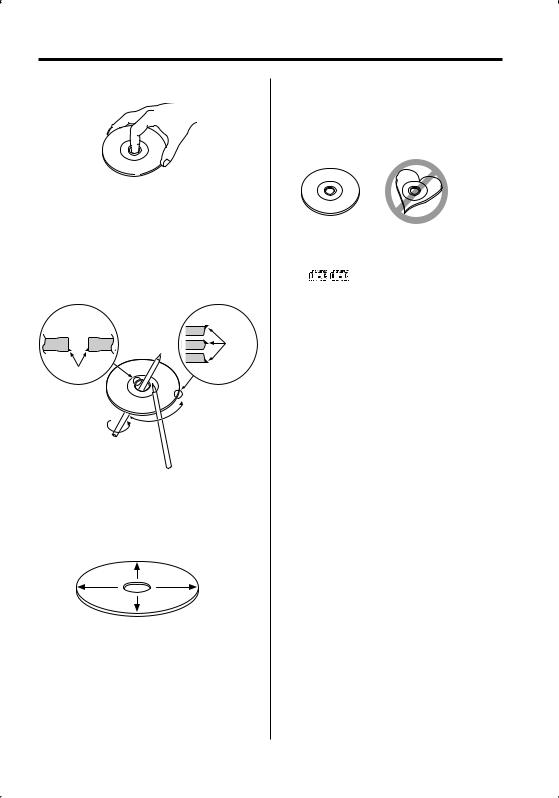
About CDs
Handling CDs
• Don’t touch the recording surface of the CD.
•CD-R and CD-RW are easier to damage than a normal music CD. Use a CD-R or a CD-RW after reading the caution items on the package etc.
•Don’t stick tape etc. on the CD.
Also, don’t use a CD with tape stuck on it.
When using a new CD
If the CD center hole or outside rim has burrs, use it after removing them with a ball pen etc.
Burrs
Burrs
CD accessories
Don’t use disc type accessories.
CD cleaning
Clean from the center of the disc and move outward.
Removing CDs
When removing CDs from this unit pull them out horizontally.
CDs that can’t be used
• CDs that aren’t round can’t be used.
•CDs with coloring on the recording surface or that are dirty can’t be used.
•This unit can only play the CDs with


 .
.
It may not correctly play discs which do not have the mark.
•A CD-R or CD-RW that hasn’t been finalized can’t be played. (For the finalization process refer to your CD-R/CD-RW writing software, and your CD- R/CD-RW recorder instruction manual.)
CD storage
•Don’t place them in direct sunlight (On the seat or dashboard etc.) and where the temperature is high.
•Store CDs in their cases.
English | 7

Notes on playing MP3/WMA (KTS-MP400MR only)
KTS-MP400MR can play MP3 (MPEG1, 2 Audio Layer 3)/WMA. Note, however, that the MP3/WMA recording media and formats acceptable are limited. When writing MP3/WMA, pay attention to the following restrictions.
Acceptable media
The MP3/WMA recording media acceptable to this unit are CD-ROM, CD-R, and CD-RW.
When using CD-RW, do full format not quick format to prevent malfunction.
Acceptable medium formats
The following formats are available for the media used in this unit. The maximum number of characters used for file and folder name including the delimiter (".") and three-character extension are indicated in parentheses.
•ISO 9660 Level 1 (12 characters)
•ISO 9660 Level 2 (31 characters)
•Joliet (64 character; Up to 32 characters are displayed)
•Romeo (128 character; Up to 64 characters are displayed)
•Long file name (200 characters; Up to 64
characters are displayed)
•Maximum number of characters for folder name: 64 (Joliet; Up to 32 characters are displayed)
For a list of available characters, see the instruction manual of the writing software and the section Entering file and folder names below.
The media reproducible on this unit has the following limitations:
•Maximum number of directory levels: 8
•Maximum number of files per folder: 255
•Maximum number of folders: 50
•Maximum number of files and folders: 512 MP3/WMA written in the formats other than the above may not be successfully played and their file names or folder names are not properly displayed.
Settings for your MP3/WMA encoder and CD writer
Do the following setting when compressing audio data in MP3/WMA data with the MP3/WMA encoder.
• Transfer bit rate: MP3: 8 —320 kbps WMA: 48 —192 kbps
•Sampling frequency
MP3: 8, 11.025, 12, 16, 22.05, 24, 32, 44.1, 48 kHz WMA: 32, 44.1, 48 kHz
When you use your CD writer to record MP3/WMA up to the maximum disc capacity, disable additional writing. For recording on an empty disc up to the maximum capacity at once, check Disc at Once.
•Play mode may not be possible when portions of the functions of Windows Media Player 9 or higher are used.
Entering ID3 tag
The Displayable ID3 tag is ID3 version 1.x.
For the character code, refer to the List of Codes.
Entering file and folder names
The code list characters are the only file names and folder names that can be entered and displayed.
If you use any other character for entry, the file and folder names are not displayed correctly. They may neither be displayed correctly depending on the CD writer used.
The unit recognizes and plays only those MP3/WMA which have the MP3/WMA extension (.MP3/.WMA).
•A file with a name entered with characters not on the code list may not play correctly.
Writing files into a medium
When a medium containing MP3/WMA data is loaded, the unit checks all the data on the medium. If the medium contains a lot of folders or non-MP3/ WMA files, therefore, it takes a long time until the unit starts playing MP3/WMA.
In addition, it may take time for the unit to move to the next MP3/WMA file or a File Search or Folder Search may not be performed smoothly.
Loading such a medium may produce loud noise to damage the speakers.
•Do no attempt to play a medium containing a non-MP3/ WMA file with the MP3/WMA extension.
The unit mistakes non-MP3/WMA files for MP3/WMA data as long as they have the MP3/WMA extension.
•Do not attempt to play a medium containing non MP3/ WMA.
8 | English

MP3/WMA playing order
When selected for play, Folder Search, File Search, or for Folder Select, files and folders are accessed in the order in which they were written by the CD writer.
Because of this, the order in which they are expected to be played may not match the order in which they are actually played. You may be able to set the order in which MP3/WMA are to be played by writing them onto a medium such as a CD-R with their file names beginning with play sequence numbers such as "01" to "99", depending on your CD writer.
For example, a medium with the following folder/ file hierarchy is subject to Folder Search, File Search, or Folder Select as shown below.
Example of a medium’s folder/file hierarchy
Folder
File
Root
Level 1 |
Level 3 |
Level 5 |
Level 2 |
|
Level 4 |
When a File Search is executed with file ¡$
being played ...
Operation of |
(Current file: ¡$) |
|
the button |
||
|
||
|
|
|
4 Button |
Beginning of file ¡$ ¡# |
|
¢ Button |
¡% ¡& |
|
|
|
When a Folder Search is executed with file ¡$
being played ...
Operation of |
(Current folder: 4) |
|||
the button |
||||
|
|
|
||
AM Button |
3 |
2 1 |
8 ... |
|
FM Button |
5 |
6 7 |
...8 1 |
|
|
|
|
|
|
When Folder Select is selected with file ¡$
being played to move from folder to folder ...
Operation of |
(Current folder: 4) |
|
the button |
||
|
||
4 Button |
3 |
|
¢ Button |
6 |
|
|
|
|
AM Button |
2 |
|
FM Button |
5 |
|
|
|
English | 9

General features
'. 56 43 $% $)
.65& |
|
|
|
|
|
|
|
|
|
|
|
|
|
|
|
|
|
|
|
|
|
|
|
|
|
|
|
|
|
|
|
|
|
|
|
|
|
|
|
|
|
|
|
|
|
|
D |
|
|
%*41 |
2 |
||||
". 48 |
|
108&3 |
/".& 4&5 |
"6% |
||||||
|
|
|
|
|
||||||
Power
Turning ON the Power
Press the [POWER] button.
Turning OFF the Power
Press the [POWER] button.
Selecting the Source
Press the [TU/SR] button.
Source required |
Display |
Tuner or HD Radio (Optional accessory) |
"TUNER" or "HD Radio" |
SIRIUS tuner (Optional accessory) |
"SIRIUS" |
Weather Band Tuner (Optional accessory) |
"Weather Band" |
Press the [CD/CH] button. |
|
|
|
Source required |
Display |
CD |
"CD" |
External disc (Optional accessory) |
"CD CH"/"CD2" |
Auxiliary input (Optional accessory) |
"AUX EXT" |
Volume
Increasing Volume
Press the [u] button.
Decreasing Volume
Press the [d] button.
Attenuator
Turning the volume down quickly.
Press the [MUTE] button.
Each time the button is pressed, the Attenuator turns ON and OFF.
When it’s ON, "MUTE ON" is displayed.
10 | English

System Q
You can recall the best sound setting preset for different types of music.
1Select the source to set
Press the [TU/SR] or [CD/CH] button.
2Select the Sound type
Press the [Q] button.
Each time the button is pressed the sound setting switches.
Sound setting |
Display |
Flat |
"Flat" |
User memory |
"User" |
Rock |
"Rock" |
Pops |
"Pops" |
Easy |
"Easy" |
Top 40 |
"Top40" |
Jazz |
"Jazz" |
•User memory: The values set on the <Audio Control> (page 11).
Audio Control
1Select the source for adjustment
Press the [TU/SR] or [CD/CH] button.
2Enter Audio Control mode
Press the [AUD] button for at least 1 second.
3Select the Audio item for adjustment
Press the [FM] or [AM] button.
Each time the button is pressed the items that can be adjusted switch as shown below.
4Adjust the Audio item
Press the [4] or [¢] button.
Adjustment Item |
Display |
Range |
Bass Center Frequency*2 |
"Bass F" |
60/70/80/100 or 150 Hz |
Bass level |
"Bass" |
–8 — +8 |
Bass Q Factor*2 |
"Bass Q" |
1.00/1.25/1.50/2.00 |
Bass Extend*2 |
"Bass EXT" |
ON/OFF |
Middle Center Frequency*2 |
"MID F" |
0.5/1.0/1.5/2.0 kHz |
Middle level |
"Middle" |
–8 — +8 |
Middle Q Factor*2 |
"Middle Q" |
1.0/2.0 |
Treble Center Frequency*2 |
"TRE F" |
10.0/12.5/15.0/17.5 kHz |
Treble level |
"Treble" |
–8 — +8 |
Balance |
"Balance" |
Left 15 — Right 15 |
Fader |
"Fader" |
Rear 15 — Front 15 |
Sub woofer level*1 |
"SW Level" |
–15 — +15 |
Front High Pass Filter*2 |
"HPF F" |
Through/100/125/ |
|
|
170 Hz |
Rear High Pass Filter*2 |
"HPF R" |
Through/200 Hz |
Front/Rear High Pass |
"HPF" |
Through/100/125/170 |
Filter*3 |
|
Hz |
Sub woofer Low Pass |
"LPF SW" |
50/80/120/THRU Hz |
Filter*1 |
|
|
Volume offset |
"V-Offset" |
–8 — ±0 |
Loudness |
"LOUD" |
ON/OFF |
•According to the Bass Q Factor setting value, the frequencies that can be set in Bass Center Frequency change as shown below.
Bass Q Factor |
Bass Center Frequency |
1.00/1.25/1.50 |
60/70/80/100 |
2.00 60/70/80/150
•When the Bass Extend is set to ON, low frequency response is extended by 20%.
•Volume offset: Each source’s volume can be set as a
difference from the basic volume.
• Loudness: Compensating for low and high tones during low volume.
•*1 You can control this item when <Switching preout> (page 23) is set to "SWPRE Sub-W". (KTS-300MR only)
•*2 Function of the KTS-MP400MR
•*3 Function of the KTS-300MR
5Exit Audio Control mode
Press the [AUD] button.
English | 11

General features
Switching Display
Switching the information displayed.
Press the [DISP] button.
Each time the button is pressed the display switches as shown below.
In Tuner source
|
Information |
Display |
|
Station name or Frequency |
"SNPS"* |
|
Frequency |
"BAND+FREQ" |
|
Clock |
|
In CD & External disc source |
||
|
|
|
|
Information |
Display |
|
Disc title (In External disc source or |
"D-TITLE"* |
|
KTS-MP400MR internal CD source) |
|
|
Track title (In External disc source or |
"T-TITLE"* |
|
KTS-MP400MR internal CD source) |
|
|
Track number & Play time |
"P-Time" |
|
Disc name |
"DNPS" |
|
Clock |
|
In MP3/WMA source (KTS-MP400MR only)
|
Information |
Display |
|
Song title & Artist name |
"TITLE"* |
|
Album name & Artist name |
"ALBUM"* |
|
Folder name |
"FOLDER NAME" |
|
File name |
"FILE NAME" |
|
Track number & Play time |
"P-Time" |
|
Clock |
|
In HD Radio source |
|
|
|
|
|
|
Information |
Display |
|
Station name |
"Station Name"* |
|
Song title/ Artist name/ |
"Title"* |
|
Album name/ Genre |
|
|
Frequency |
"Frequency" |
|
Clock |
|
In Weather Band Tuner source
Information
Frequency
Clock
In Auxiliary input source
Information
Auxiliary input name
Clock
•* If the contents of the information cannot be displayed, Play time or Frequency is displayed.
•Album name cannot be displayed in WMA file.
Station/Disc Naming (SNPS/DNPS)
Attaching a title to a Station or CD.
1Receive/play the station/disc you want to attach a title to
•Refer to the <Switching Display> (page 12) and select either "DNPS" or "SNPS". No name can be attached to the source if "DNPS" or "SNPS" cannot be selected for it.
2Enter name set mode
Press the [NAME SET] button for at least 2 seconds.
"NAME SET" is displayed.
3Move the cursor to the enter character position
Press the [4] or [¢] button.
4Select the character type
Press the [3/8] button.
Each time the button is pressed the character type switches as shown below.
Character type
Alphabet upper case Alphabet lower case Numbers and symbols
Special characters (Accent characters)
5Select the characters
Press the [FM] or [AM] button.
6Repeat steps 3 through 5 and enter the name.
7Exit name set mode
Press the [NAME SET] button.
•When operation stops for 10 seconds the name at that time is registered, and Name Set mode closes.
12 | English

•Memory numbers
-FM: 32 stations
-AM: 16 stations
-Internal CD player: 30 discs
-External CD changer/ player: Varies according to the CD changer/ player. Refer to the CD changer/ player manual.
•The title of station/CD can be changed by the same operation used to name it.
Auxiliary Input Display Setting
Selecting the display when this device is switched to Auxiliary input source.
1Select Auxiliary input source
Press the [CD/CH] button.
Select the "AUX EXT" display.
2Enter Auxiliary input display setting mode
Press the [NAME SET] button for at least 2 seconds.
The presently selected AUX Name is blinks.
3Select the Auxiliary input display
Press the [4] or [¢] button.
Each time the button is pressed it switches through the below displays.
•"AUX EXT"
•"TV"
•"VIDEO"
•"GAME"
•"PORTABLE"
•"DVD"
4Exit Auxiliary input display setting mode
Press the [NAME SET] button.
•When operation stops for 10 seconds, the name at that time is selected, and Auxiliary input display setting mode closes.
•The Auxiliary input display can be set only when the auxiliary input of optional KCA-S210A is used.
Subwoofer Output
Turning the Subwoofer output ON or OFF.
Press the [SW] button for at least 1 second.
Each time the button is pressed Subwoofer output switches ON or OFF.
When it’s ON, "Sub-W ON" is displayed.
•You can control this function when <Switching preout> (page 23) is set to "SWPRE Sub-W". (KTS300MR only)
TEL Mute
The audio system automatically mutes when a call comes in.
When a call comes in
"CALL" is displayed.
The audio system pauses.
Listening to the audio during a call
Press the [TU/SR] or [CD/CH] button.
The "CALL" display disappears and the audio system comes back ON.
When the call ends
Hang up the phone.
The "CALL" display disappears and the audio system comes back ON.
English | 13

Tuner features
'.56 43
|
|
|
|
|
|
|
|
|
|
|
|
|
|
|
|
|
|
|
|
|
|
|
|
|
|
|
|
|
|
|
|
|
|
|
|
|
|
|
|
|
|
|
|
|
|
|
|
|
|
|
|
|
|
|
|
|
|
|
|
|
|
|
|
|
|
|
D |
o |
"650 |
||||||||
". |
|
|
|
|
|
|
|
".& |
||||
|
|
|
|
|
|
|
|
|
|
|||
Band display |
Frequency display |
Preset station number |
ST indicator |
Tuning
Selecting the station.
1Select tuner source
Press the [TU/SR] button.
Select the "TUNER" display.
2Select the band
Press the [FM] or [AM] button.
Each time the [FM] button is pressed it switches between the FM1, FM2, and FM3 bands.
3Tune up or down band
Press the [4] or [¢] button.
•During reception of stereo stations the "ST" indicator is ON.
Tuning Mode
Choose the tuning mode.
Press the [AUTO] button.
Each time the button is pressed the Tuning mode switches as shown below.
Tuning mode |
Display |
Operation |
Auto seek |
"Auto 1" |
Automatic search for a station. |
Preset station seek |
"Auto 2" |
Search in order of the stations |
|
|
in the Preset memory. |
Manual |
"Manual" |
Normal manual tuning control. |
14 | English

Station Preset Memory
Putting the station in the memory.
1Select the band
Press the [FM] or [AM] button.
2Select the frequency to put in the memory
Press the [4] or [¢] button.
3Put the frequency in the memory
Press the desired [1] — [6] button for at least 2 seconds.
The preset number display blinks 1 time. On each band, 1 station can be put in the memory on each [1] — [6] button.
Auto Memory Entry
Putting stations with good reception in the memory automatically.
1Select the band for Auto Memory Entry
Press the [FM] or [AM] button.
2Open Auto Memory Entry
Press the [AME] button for at least 2 seconds.
When 6 stations that can be received are put in the memory Auto Memory Entry closes.
Preset Tuning
Calling up the stations in the memory.
1Select the band
Press the [FM] or [AM] button.
2Call up the station
Press the desired [1] — [6] button.
English | 15
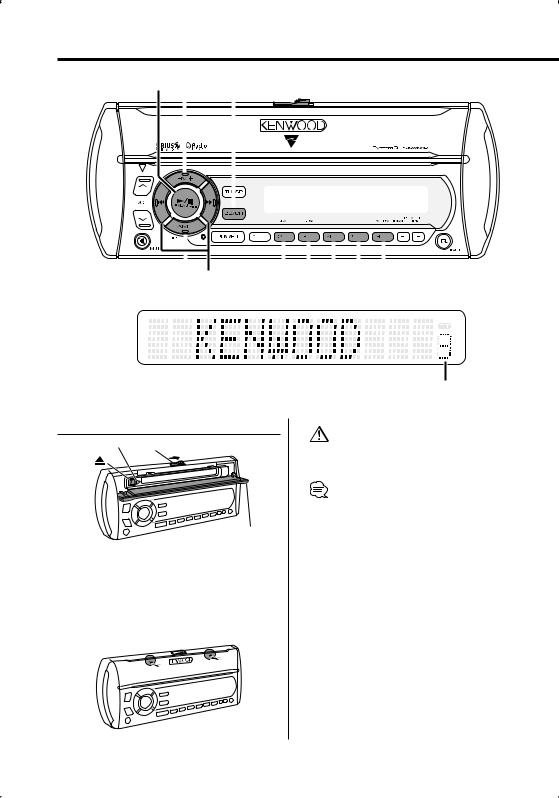
CD/MP3/WMA/External disc control features
'. |
$% $) |
Release lever |
||||
|
|
|
|
|
|
|
|
|
|
|
|
|
|
|
|
|
|
|
|
|
|
|
|
|
|
|
|
|
|
|
|
|
|
|
|
|
|
|
|
|
|
|
D |
|
|
|
|
|
|
|
|
|
|
|
|
|
|
|
|
|
|
3%. |
|
'4&- |
|
|||
". |
4$ |
"/ 3&1 |
. 3%. |
|||||
Disc number
Playing CD & MP3/WMA
0/3(IN) indicator |
Release lever |
CD door
When there is no disc inserted
1Slide the Release lever.
Pull down the CD door to open it.
2Insert a disc.
3Close the CD door
Press the CD door in the center when closing.
•Do not use the unit with the CD door in the open condition. If it’s used in the open position water can enter the inside part and cause damage.
•When a disc is inserted, the "0"/ "3"(IN) indicator is ON.
When a disc is inserted
Press the [CD/CH] button.
Select the "CD" display.
Pause and play
Press the [3/8] button.
Each time the button is pressed it pauses and plays.
16 | English
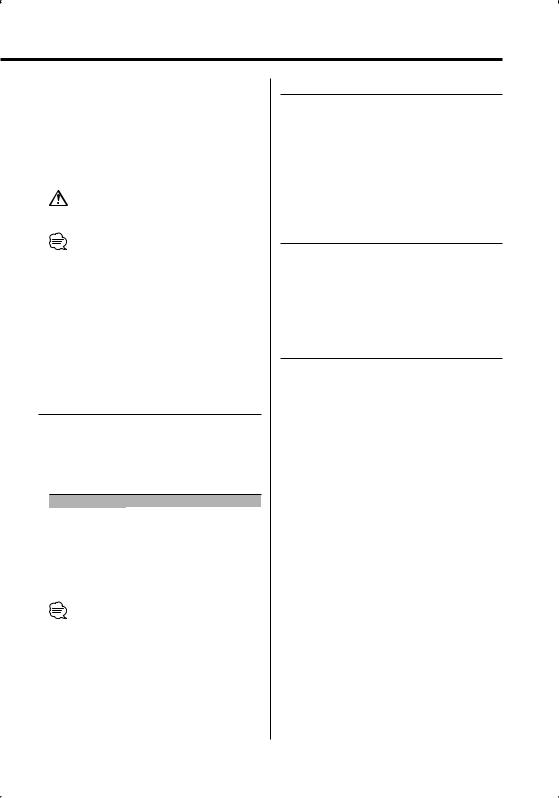
Eject the disc
1Slide the Release lever.
Pull down the CD door to open it.
2Eject the disc
Press the [0] button.
3Close the CD door
Press the CD door in the center when closing.
•3 in. (8cm) disc can’t be played. Using an adapter and inserting them into this unit can cause damage.
•The MP3/WMA media that this unit can play are CDROM, CD-R, and CD-RW.
The medium formats must be ISO 9660 Level 1, Level 2, Joliet, or Romeo. The methods and precautions to be followed for writing MP3/WMA data are covered in <Notes on playing MP3/WMA> (page 8).
Check that section before creating your MP3/WMA media.
Playing External Disc
Playing discs set in the optional accessory disc player connected to this unit.
Press the [CD/CH] button.
Select the display for the disc player you want.
Display examples:
Display |
Disc player |
"CD2" |
CD player |
"CD CH" |
CD changer |
Pause and play
Press the [3/8] button.
Each time the button is pressed it pauses and plays.
•Disc 10 is displayed as "0".
•The functions that can be used and the information that can be displayed will differ depending on the external disc players being connected.
Fast Forwarding and Reversing
Fast Forwarding
Hold down on the [¢] button.
Release your finger to play the disc at that point.
Reversing
Hold down on the [4] button.
Release your finger to play the disc at that point.
Track/File Search
Searching for a song on the disc or in the MP3/ WMA folder.
Press the [4] or [¢] button.
Function of disc changer/ MP3/ WMA
Disc Search/Folder Search
Selecting the disc set in the Disc changer or the folder recorded on the MP3/WMA media.
Press the [AM] or [FM] button.
English | 17
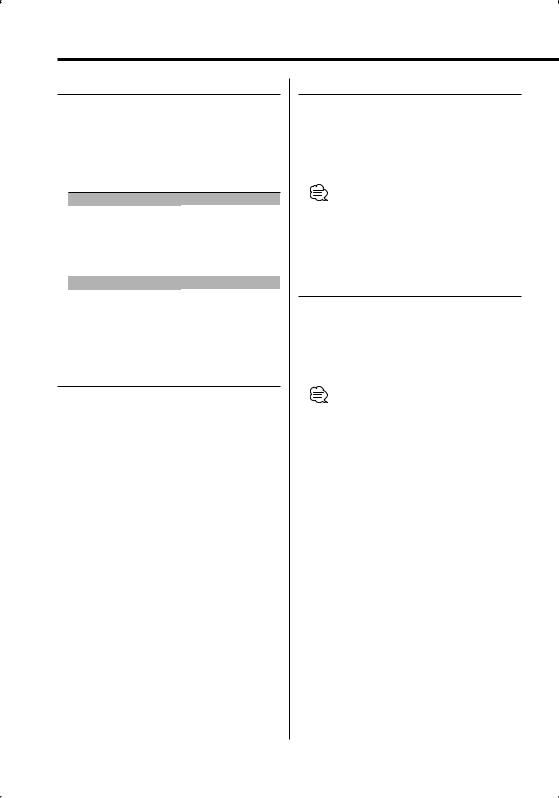
CD/MP3/WMA/External disc control features
Track/File/Disc/Folder Repeat
Replaying the song, disc in the Disc changer or MP3/WMA folder you’re listening to.
Press the [REP] button.
Each time the button is pressed the Repeat Play switches as shown below.
In CD & External disc source
|
Repeat play |
Display |
|
Track Repeat |
"(T-)Repeat ON" |
|
Disc Repeat (In Disc Changer) |
"D-Repeat ON" |
|
OFF |
"Repeat OFF" |
In MP3/WMA source |
|
|
|
|
|
|
Repeat play |
Display |
|
File Repeat |
"File REP ON" |
|
Folder Repeat |
"FOLD REP ON" |
|
OFF |
"Repeat OFF" |
Scan Play
Playing the first part of each song on the disc or MP3/WMA folder you are listening to and searching for the song you want to listen to.
1Start Scan Play
Press the [SCAN] button.
"Scan ON" is displayed.
2Release it when the song you want to listen to is played
Press the [SCAN] button.
Random Play
Play all the songs on the disc or MP3/WMA folder in random order.
Press the [RDM] button.
Each time the button is pressed Random Play turns ON or OFF.
When it’s ON, "Random ON" is displayed.
•When the [¢] button is pressed, the next song select starts.
Function of disc changer
Magazine Random Play
Play the songs on all the discs in the disc changer in random order.
Press the [M.RDM] button.
Each time the button is pressed the Magazine Random Play turns ON or OFF.
When it’s ON, "M-Random ON" is displayed.
•When the [¢] button is pressed, the next song select starts.
18 | English

Function of the KTS-MP400MR
Function of MP3/WMA
Folder Select
Quickly selecting the folder you want to listen to.
1Enter Folder Select mode
Press the [F.SEL] button.
"Select Mode" is displayed.
During Select mode the folder information is displayed as shown below.
Folder name display
Displays the current folder name.
2Select the folder level
Press the [FM] or [AM] button.
With the [FM] button you move 1 level down and with the [AM] button 1 level up.
Selecting a folder in the same level
Press the [4] or [¢] button.
With the [4] button you move to the previous folder, and with the [¢] button to the next folder.
Returning to the top level
Press the [3] button.
3Decide the folder to play
Press the [3/8] button.
The Folder Select mode releases, and the MP3/ WMA in the folder being displayed is played.
•The methods for moving to other folders in the folder select mode are different from those in the folder search mode.
See <Notes on playing MP3/WMA> (page 8) for details.
Canceling the Folder Select mode
Press the [F.SEL] button.
Text/Title Scroll
Scrolling the displayed CD text, or MP3/WMA text.
Press the [DISP] button for at least 1 second.
English | 19
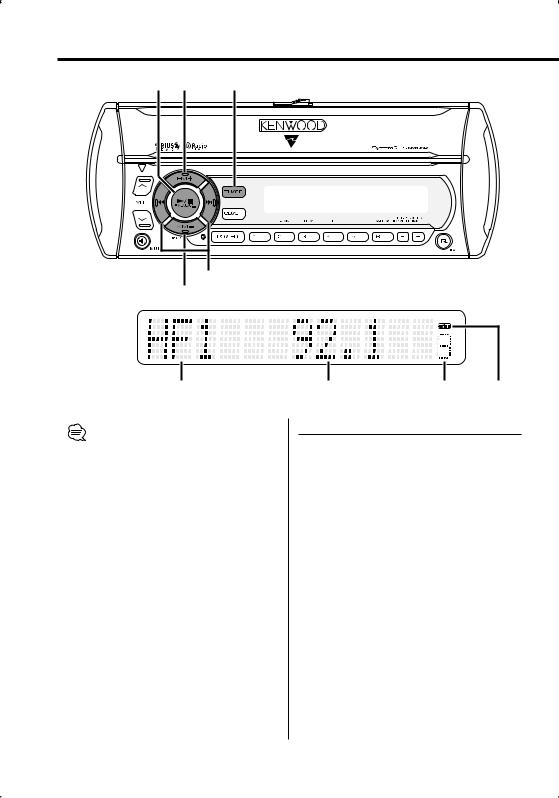
HD Radio control features
.&/6 '. 56 43
D
".
Band display
•When you connect an HD Radio, Tuner features of the unit are disabled and switched to HD Radio tuner features. A portion of the setting methods including the Tuning Mode will change.
•With the HD Radio tuner, you can use the similar functions to <Station Preset Memory> and <Preset Tuning> of Tuner features. Refer to Tuner features for how to use the functions.
•The HD Radio cannot be selected as a dual zone source.
Frequency display |
Preset station number |
ST indicator |
Tuning
Selecting the station.
1Select HD Radio source
Press the [TU/SR] button.
Select the "HD Radio" display.
2Select the HD FM band
Press the [FM] button.
Each time the [FM] button is pressed it switches between the HF1, HF2, and HF3 bands.
Select the HD AM band
Press the [AM] button.
3Tune up or down band
Press the [4] or [¢] button.
20 | English

Auto Memory Entry
Putting a station with good reception in the memory automatically.
1Select the band for Auto Memory Entry
Press the [FM] or [AM] button.
2Enter Menu mode
Press the [MENU] button for at least 1 second.
"MENU" is displayed.
3Select the Auto Memory Entry mode
Press the [FM] or [AM] button.
Select the "Auto-Memory" display.
4Open Auto Memory Entry
Press the [4] or [¢] button for at least 2 seconds.
When 6 stations that can be received are put in the memory Auto Memory Entry closes.
5Exit Menu mode
Press the [MENU] button.
•The receiving method can be switched with the setting of <Receive mode Setting> (page 26).
English | 21

Menu system
.&/6 '.
D
".
Menu System
Setting during operation beep sound etc. functions.
The Menu system basic operation method is explained here. The reference for the Menu items and their setting content is after this operation explanation.
1Enter Menu mode
Press the [MENU] button for at least 1 second.
"MENU" is displayed.
2Select the menu item
Press the [FM] or [AM] button.
Example: When you want to set the beep sound select the "Beep" display.
3Set the menu item
Press the [4] or [¢] button.
Example: When "Beep" is selected, each time the button is pressed it switches "Beep ON" or "Beep OFF". Select 1 of them as the setting.
You can continue by returning to step 2 and setting other items.
22 | English
4Exit Menu mode
Press the [MENU] button.
•When other items that are applicable to the basic operation method above are displayed afterwards their setting content chart is entered. (Normally the uppermost setting in the chart is the original setting.) Also, the explanation for items that aren’t applicable (<Manual Clock Adjustment> etc.) are entered step by step.
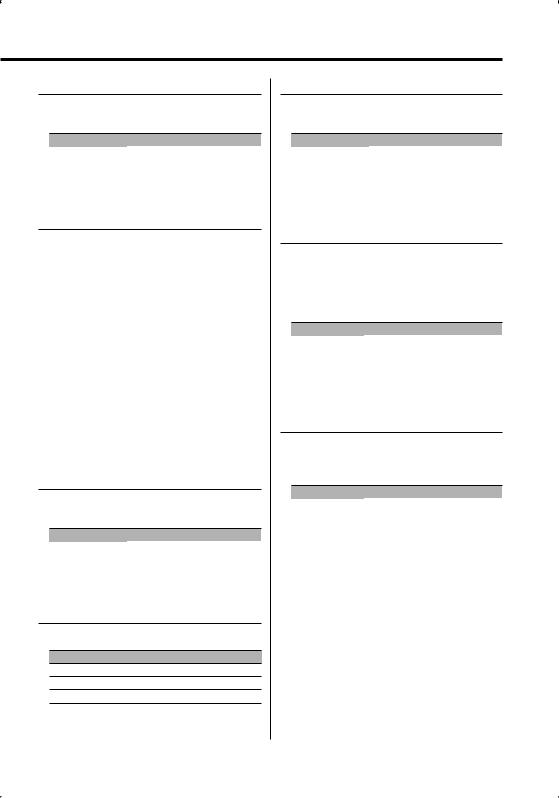
Touch Sensor Tone
Setting the operation check sound (beep sound) ON/OFF.
Display |
Setting |
"Beep ON" |
Beep is heard. |
"Beep OFF" |
Beep canceled. |
Manual Clock Adjustment
1Select Clock Adjustment mode
Press the [FM] or [AM] button.
Select the "Clock Adjust" display.
2Enter Clock Adjust mode
Press the [4] or [¢] button for at least 1 second.
The clock display blinks.
3Adjust the hours
Press the [FM] or [AM] button.
Adjust the minutes
Press the [4] or [¢] button.
4Exit Clock adjustment mode
Press the [MENU] button.
Selectable Illumination
Selecting the button illumination color as green or red.
Display |
Setting |
"Button Red" |
The illumination color is red. |
"Button Green" |
The illumination color is green. |
Contrast Adjustment
Adjusting the display contrast.
Display and Setting
"Contrast 0"
…
"Contrast 10"
Dimmer
Dimming this unit’s display automatically when the light switch is turned ON.
Display |
Setting |
"Dimmer ON" |
The display dims. |
"Dimmer OFF" |
The display doesn’t dim. |
Function of the KTS-MP400MR
System Q Setting
Setting whether the display indicates the System Q factors (Bass center frequency, Bass Q factor, Bass extend, Middle center frequency, Middle
Q factor, and Treble center frequency) in Audio control.
Display |
Setting |
"System Q ON" |
The System Q factors are displayed. |
"System Q OFF" |
The System Q factors aren’t displayed. |
Function of the KTS-300MR
Switching preout
Switching the preout between the rear and subwoofer. (In subwoofer it outputs without effect from the fader control.)
Display |
Setting |
"SWPRE Rear" |
Rear preout. |
"SWPRE Sub-W" |
Subwoofer preout. |
English | 23

Menu system
Built-in Amp Mute Setting
Toggles ON or OFF the mute control on the builtin amplifier.
Turning ON this control enhances the preout quality.
Display |
Setting |
"AMP Mute OFF" |
The built-in amplifier activates. |
"AMP Mute ON" |
The built-in amplifier deactivates. |
In SIRIUS tuner source
SIRIUS ID (ESN) display
Displaying the SIRIUS ID (Electronic Serial
Number) display.
Display
"ESN = ************"
•Serial & SIRIUS ID (ESN)
It is especially important to retain the unit serial number and the electronic SIRIUS Identification number for service activation and potential future service changes.
In SIRIUS Tuner, External disc, or Auxiliary input source
Dual Zone System
Makes the sound different for the front channel and rear channel.
Display |
|
Setting |
"Zone 2 |
OFF" |
The front and rear are the same source sound. |
"Zone 2 |
ON" |
The front and rear are the different source sound. |
•When the Dual Zone System is on, there is only sound effect including Audio control for internal source.
•When you set the Dual zone system to ON while the sub woofer preout is switched ON, the sound of the sub woofer preout isn’t output.
When the Dual Zone System is OFF
Dual Zone System Setting
Setting the Front channel and Rear channel sound in the Dual Zone System.
Display |
Setting |
|
"Zone 2 |
Rear" |
The front is this unit’s internal source, and the rear |
|
|
is selected source sound. |
"Zone 2 |
Front" |
The rear is this unit’s internal source, and the front |
|
|
is selected source sound. |
24 | English

B.M.S. (Bass Management System)
Adjust the bass boost level of the external amplifier using the main unit.
Display |
Setting |
"AMP Bass FLT" |
Bass boost level is flat. |
"AMP Bass +6" |
Bass boost level is low (+6dB). |
"AMP Bass +12" |
Bass boost level is mid (+12dB). |
"AMP Bass +18" |
Bass boost level is high (+18dB). |
•Refer to the catalog or instruction manual for power amplifiers that can be controlled from this unit.
•For amplifiers there are the model that can be set from Flat to +18 dB, and the model that can be set from Flat to +12 dB.
When an amplifier that can only be set to +12 is connected to the unit, "AMP Bass +18" won’t work correctly even if it’s selected.
B.M.S. Frequency Offset
Setting the central frequency boosted by B.M.S.
Display |
Setting |
"AMP Freq NML" |
Boost with the normal central frequency. |
"AMP Freq Low" |
Drop the normal central frequency 20%. |
In FM reception
CRSC (Clean Reception System Circuit)
Temporarily have reception switched from stereo to mono to reduce multi-path noise when listening to the FM station.
Display |
Setting |
"CRSC ON" |
The CRSC is ON. |
"CRSC OFF" |
The CRSC is OFF. |
•Strong electrical fields (such as from power lines) may cause unstable sound quality when CRSC is turned ON. In such a situation, turn it OFF.
When LX AMP unit connecting
AMP Control
You can control the LX AMP connected to the unit.
1Select AMP Control mode
Press the [FM] or [AM] button.
Select the "AMP Control" display.
2Enter AMP Control mode
Press the [4] or [¢] button for at least 1 second.
3Select the AMP Control item for adjustment
Press the [FM] or [AM] button.
•For the details of the AMP Control item, see the Instruction manual attached to the LX AMP.
4Adjust the AMP Control item
Press the [4] or [¢] button.
5Exit AMP Control mode
Press the [MENU] button.
English | 25

Menu system
In HD Radio mode
Receive mode Setting
Sets the receive mode.
1Select the Receive mode
Press the [FM] or [AM] button.
Select the "Receive Mode" display.
2Open Receive mode
Press the [4] or [¢] button for at least 1 second.
3Set the Receive mode
Press the [FM] or [AM] button.
Each time the button is pressed the Receive mode switches as shown below.
Receive mode |
Display |
Operation |
Auto mode |
"Auto" |
Analog broadcasts and digital |
|
|
broadcasts will be switched |
|
|
automatically. |
|
|
When both are being transmitted, |
|
|
the digital broadcast will have |
|
|
priority. |
Digital |
"Digital" |
Digital broadcasts only. |
Analog |
"Analog" |
Analog broadcasts only. |
4Exit Receive mode
Press the [MENU] button.
•Even if the "Auto" setting, an analog broadcast will be received during the reception of a ball game mode (non-delayed broadcast program).
In HD Radio mode
Tuning Mode
Sets the tuning mode.
Tuning mode |
Display |
Operation |
Auto seek |
"Auto 1" |
Automatic search for a station. |
Preset station seek |
"Auto 2" |
Search in order of the stations |
|
|
in the Preset memory. |
Manual |
"Manual" |
Normal manual tuning control. |
In HD Radio mode
Auto Memory Entry
For the operation method refer to <Auto Memory Entry> (page 21).
26 | English

Basic Operations of Optional Hardwired Remote
.65& '. 56 43 $% $)
70- D
". 108&3
• Refer to the instruction manual of Remote controller.
Basic operations
[POWER] button
Turning ON the Power
Press the [POWER] button for at least 1 second.
Turning OFF the Power
Press the [POWER] button.
[VOL] buttons
Adjusting the volume.
[TU/SR] or [CD/CH] button
Each time the button is pressed the source switches.
For the source switching order refer to <Selecting the Source> (page 10).
[MUTE] button
Turning the volume down quickly.
When it is pressed again it returns to the previous level.
In Tuner source
[FM]/ [AM] buttons
Select the band.
Each time the [FM] button is pressed it switches between the FM1, FM2, and FM3 bands.
[4]/ [¢] buttons
Tune up or down band.
In Disc source
[4]/ [¢] buttons
Doing track/file forward and backward.
[FM]/ [AM] buttons
Doing disc/folder forward and backward.
English | 27

Basic Operations of Optional Hardwired Remote
In HD Radio source
[FM] button
Select the HD FM band.
Each time the [FM] button is pressed it switches between the HF1, HF2, and HF3 bands.
[AM] button
Select the HD AM band.
[4]/ [¢] buttons
Tune up or down band.
In SIRIUS tuner source
[FM] buttons
Select the preset band.
[4]/ [¢] buttons
Search up or down channel.
28 | English
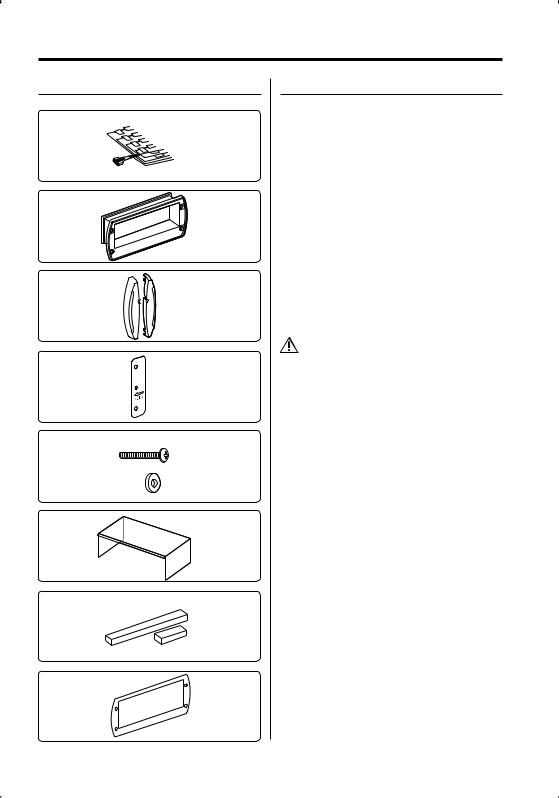
Accessories/ Installation Procedure
Accessories
..........1
..........1
..........1
..........2
..........4
..........1
..........1
..........1
Installation Procedure
1.To prevent a short circuit, remove the key from the ignition and disconnect the - battery.
2.Make the proper input and output wire connections for each unit.
3.Connect the speaker wires of the wiring harness.
4.Connect the wiring harness wires in the following order: ground, battery, ignition.
5.Connect the wiring harness connector to the unit.
6.Install the unit in your vessel.
7.Reconnect the - battery.
8.Press the reset button.
2WARNING
If you connect the ignition wire (red) and the battery wire (yellow) to the negative ground point, you may cause a short circuit, that in turn may start a fire. Always connect those wires to the power source running through the fuse box.
•If your vessel ignition does not have an ACC position, connect the ignition wire to a power source that can be turned on and off with the key or other control switch. If the receiver is left on for an extended period of time the battery may die.
•If the fuse blows, first make sure the wires aren’t touching to cause a short circuit, then replace the old fuse with one with the same rating.
•Insulate unconnected wires with vinyl tape or other similar material. To prevent a short circuit, do not remove the caps on the ends of the unconnected wires or the terminals.
•Connect the speaker wires correctly to the terminals to which they correspond. The unit may be damaged or fail to work if you share the - wires or ground them to any metal part in the vessel.
•When only two speakers are being connected to the system, connect the connectors either to both the front output terminals or to both the rear output terminals (do not mix front and rear). For example, if you connect the + connector of the left speaker to a front output terminal, do not connect the - connector to a rear output terminal.
•After installing the unit, check to make sure that electrical equipment such as the signal lamps and gauges operate normally.
•Mount the unit so that the mounting angle is 30° or less.
English | 29

Connecting Wires to Terminals
|
KTS-MP400MR |
KTS-300MR |
A |
Rear output |
– |
B |
Front output |
Front output |
C |
Subwoofer output |
Rear output/ Subwoofer output |
 Left output (White), Right output (Red)
Left output (White), Right output (Red)
A |
B |
/ ," ,,
To Wired remote controller |
|
|
|
|
|
|
|
|
|
|
|
||
To Kenwood disc changer/ |
|
|
|
|
|
|
Sirius satellite radio tuner/ |
|
|
|
|
|
|
External optional accessory |
|
|
|
|
|
|
To connect these leads, refer to |
Fuse (10A) |
|||||
the relevant instruction manuals. |
||||||
|
|
|
|
|
||
If no connections are made, do not let the wire come out from the tab.
Connect either to the power control terminal when
using the optional power amplifier, or to the antenna *° " / control terminal in the vessel.
Connect to the terminal that is grounded when either
1/
the telephone rings or during conversation.
|
|
To light control switch |
|
To "EXT.AMP.CONT." terminal of the amplifier having the |
|
||
external amp control function. |
|
|
|
Do not let the wire come out from the tab. |
/° |
||
|
|
|
ÊÊÊ " / |
|
|
To front left speaker |
White/Black |
|
|
|
White |
|
|
To front right speaker |
Gray/Black |
|
|
|
Gray |
|
|
To rear left speaker |
Green/Black |
|
|
|
Green |
|
|
To rear right speaker |
Purple/Black |
|
|
|
Purple |
|
Ignition key |
|
|
|
switch |
Fuse box |
|
|
|
|
ACC |
Fuse box |
|
|
|
(Main fuse) |
|
|
|
Battery |
³ |
q |
|
C
FM/AM antenna input
Wiring harness (Accessory1)
Power control/Antenna control wire (Blue/White)
TEL mute wire (Brown)
Dimmer control wire (Orange / White)
External amplifier control wire (Pink/Black)
Not Used (Blue)
," /ÊUÊ
," /ÊUÊ,
, ,ÊUÊ
, ,ÊUÊ,
Ignition wire (Red)
Battery wire (Yellow)
Ground wire (Black) -
(To a negative ground point of the vessel)
30 | English
